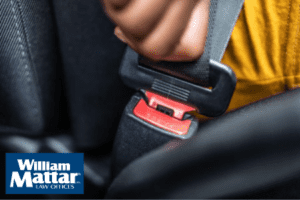
Seat belts can save lives. According to the National Highway Traffic Safety Administration (NHTSA) seat belts prevented an estimated 14,955 fatalities in 2017. Of the approximately 22,215 vehicle occupants lost in traffic crashes that same year, 47 percent were not wearing seat belts at the time of the accident.
Seat belts are meant to keep you safe, but sometimes they fail. A seat belt that fails during a motor vehicle collision can cause serious injury to occupants, resulting in injuries and resulting medical bills, physical pain, and limitations.
Keep reading to learn more about defective seat belts.
SEAT BELTS AND SAFETY
Seat belts are meant to work in combination with airbags to protect your safety during a motor vehicle collision. When an airbag deploys, the inflating bag can injure a driver if they are not properly secured by a seat belt. Buckling up can also help reduce the potential that the occupant can be ejected from the vehicle.
HOW CAN A SEAT BELT BE DEFECTIVE?
It is hard to imagine that a properly secured seat belt can fail. Unfortunately, as simple as they seem, seat belts also have the potential be defective just like any other auto part or automotive safety feature. If a seat belt is affected by a design or manufacturing defect, it may not work the way it is supposed to.
When a manufacturer produces a dangerous product that can lead to injury it has a responsibility to put out a recall notice to warn consumers about the product. Recently, for instance, Volvo recalled 2 million cars for an issue concerning front seat belts in some models.
To check if your car’s seat belt has been recalled, you can also visit the NHTSA website and enter the vehicle identification information.
DEFECTIVE SEAT BELT ACCIDENTS
Malfunctioning seat belts can fail to protect drivers and passengers during a crash, resulting in serious injuries or fatalities.
One seat belt defect, called a “false latch,” can leave an individual exposed to injury in a car accident. A seat belt with this defect can unlatch during impact, which then causes the buckle to come completely undone. Seat belts are designed to tighten during a collision to properly restrain a person and reduce movement. If a seat belt has a defect that prevents it from restraining the vehicle occupant, that person may be flung forward, causing injury.
If your seat belt failed during a motor vehicle accident, resulting in injury, it may be defective. Contact William Mattar, P.C. today to see if you have a product liability claim.
FAULTY SEAT BELT INJURIES
Faulty restraint systems can leave vehicle occupants vulnerable to injuries that may have been prevented by a well-functioning seat belt. Potential injuries include:
- Head injuries, such as a concussion;
- Facial injuries and bruises;
- Traumatic brain injuries;
- Spinal cord injuries;
- Cuts;
- Fractured and broken bones;
- Damage to internal organs;
- Paralysis; and
- Death
If you’ve suffered one of the above injuries due to a seat belt failure and are seeking an attorney, our personal injury attorneys are standing by to review your case to see if we can help.
CONTACT A DEFECTIVE AUTO PRODUCTS ATTORNEY TODAY
When a defective seat belt causes or increases injury, the team at William Mattar, P.C. is happy to review your case to see if we can help. Our attorneys represent accident victims who have been injured in a motor vehicle accident. To schedule a free initial consultation, fill out our online consultation form or give us a call at (844) 444 - 4444.